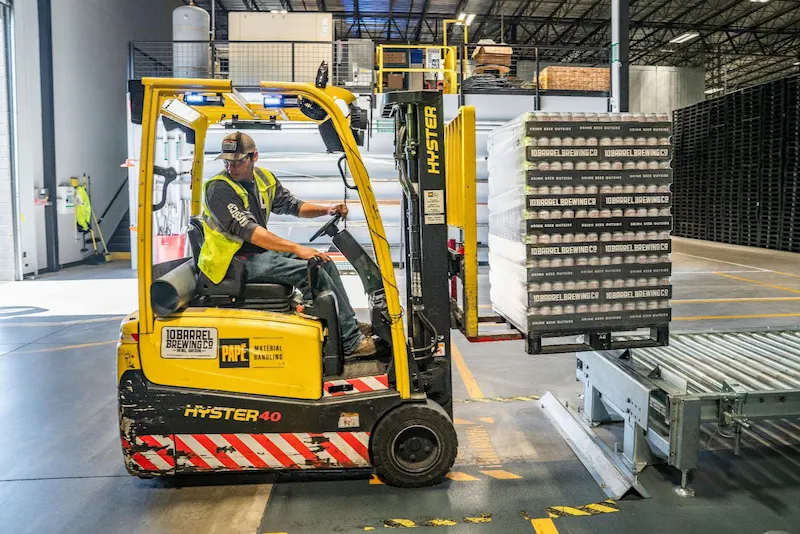Table of Contents
Efficiency is a crucial aspect of any business, and the material handling industry is no exception. With the increasing demand for faster turnaround times and strict quality standards, material handling operations are under constant pressure to improve their efficiency.
In today’s fast-paced world, traditional methods of material handling are no longer sufficient to keep up with the ever-changing demands. That’s where smart solutions come into play. By leveraging advanced technologies such as automation, IoT, and data analytics, businesses can streamline their material handling processes and achieve higher levels of efficiency.
But with so many options available in the market, it can be overwhelming to choose the right smart solution for your business. In this blog post, we will discuss how you can improve efficiency in material handling with smart solutions and the benefits they offer. Let’s dive in.
Find Storage and Material Handling Solutions
One of the first steps to improving efficiency in material handling with smart solutions is to find the right storage and material handling equipment. As seen at TheMaterialHandler.com, these include pallet racks, shelving systems, conveyor belts, and forklifts. By investing in high-quality storage and handling solutions, businesses can ensure smooth and streamlined operations.
Moreover, selecting the right type of storage and handling equipment for your specific needs can significantly improve efficiency. For example, utilizing automated pallet flow rack systems instead of traditional static racks can reduce manual labor and increase productivity. It’s essential to assess your current material handling processes and identify areas where smart solutions could make a significant impact before making any investments.
Utilize Automation Technologies
Automation is a game-changer in the material handling industry. By automating repetitive and time-consuming tasks, businesses can significantly improve their efficiency while reducing human error. Automation technologies such as conveyor systems, automated guided vehicles (AGVs), and robotic pickers are becoming increasingly popular in warehouses and distribution centers.
Additionally, automation allows for round-the-clock operations without the need for breaks or rest periods, resulting in increased productivity. It also eliminates the risk of workplace injuries, improving employee safety. Businesses can start small by implementing automation in specific areas of their material handling processes and gradually expand to other areas as needed.
Implement Real-Time Data Tracking and Analytics
Real-time data tracking and analytics play a crucial role in improving efficiency in material handling. With the help of sensors and IoT devices, businesses can gather real-time data on inventory levels, equipment performance, and employee productivity. This data can then be analyzed to identify patterns and make informed decisions regarding process improvements.
Moreover, by tracking data in real-time, businesses can detect any potential issues or bottlenecks before they lead to larger problems. It also allows for better planning and forecasting, ensuring that materials are always available when needed. By implementing real-time data tracking and analytics, businesses can achieve higher levels of efficiency while reducing waste and costs.
Integrate with IoT Systems
The Internet of Things (IoT) is transforming the material handling industry by connecting devices and systems to gather and share data. By integrating with IoT systems, businesses can create a connected ecosystem that provides real-time insights into their material handling operations.
For example, an integrated system can track product movement from production to delivery, providing valuable information at every step of the process. This allows for better coordination and communication between different departments, resulting in increased efficiency. Additionally, IoT systems can also help predict maintenance needs on equipment before they break down, reducing downtime and improving overall productivity.
You may like – The Consequences of Not Insuring Your Modern Commercial Building
Optimize Warehouse Layout and Flow
The layout and flow of a warehouse play a significant role in its efficiency. By optimizing the warehouse layout and flow, businesses can improve the movement of materials and reduce the time and effort required to complete tasks. This can be achieved by implementing lean principles, utilizing automation, and using data analytics to identify areas for improvement.
Furthermore, optimizing warehouse layout also includes organizing inventory in a logical and efficient manner, reducing travel time for employees and minimizing errors. By continuously evaluating and adjusting the warehouse layout and flow, businesses can achieve maximum efficiency in their material handling operations.
Train Employees on New Technologies

Lastly, it’s crucial to train employees on the new technologies implemented for material handling. New smart solutions may require different skills and knowledge from traditional methods, and proper training can ensure that employees are equipped to use them effectively.
Training should also include education on safety protocols and best practices when working with automated equipment or IoT systems. This will not only improve efficiency but also promote a safe working environment for employees.
It’s essential to involve employees in the adoption of smart solutions and provide ongoing training to keep up with new advancements. Investing in employee training is an investment in the success and efficiency of your material handling operations.
Improving efficiency in material handling with smart solutions can bring numerous benefits to businesses, including increased productivity, reduced costs, and improved employee safety. By finding the right storage and material handling solutions, utilizing automation technologies, implementing real-time data tracking and analytics, integrating with IoT systems, optimizing warehouse layout and flow, and training employees on new technologies, businesses can achieve higher levels of efficiency in their material handling processes. It’s crucial for businesses to continuously evaluate their operations and embrace new advancements in technology to stay competitive in today’s fast-paced market.
Want to explore something different? The Essential Guide to Understanding Typical Personal Injury Settlements

